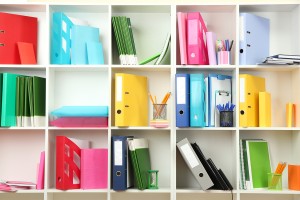Creators need stuff in order to make their magical ideas come to life, but managing all that material can be overwhelming, and your IPad won’t help.
 The way you keep all the things that inspire your ideas, is as important as having the supplies to make your art.
The way you keep all the things that inspire your ideas, is as important as having the supplies to make your art.
Your system must keep your inspiration accessible. Here are a few tips:
- Virtually anything can become a filing system for a creative persons’ ideas. Keep in mind that your system may house photos, paper notes, objects, music, computer disks or storage devices, props, failed attempts, historical timelines noting progress or other events, other artist’s work, anything that sparks your imagination.
- You may want your system to have a built-in redundancy, like copied photos and notes or duplicate objects from other filed project inspirations.
- Keeping your storage system uniform will make it easier to reference your ideas. The juice for a lot of creative ideas can be lost in search for the stuff that first gave the artist the idea.
- Use only the necessary amount of variety to house your stuff. With all the cool ways to store things it’s easy to get lost in just organizing for its own sake.
As a quick reference consider these typical types of storage; but ponder their use just like you would choose the right paintbrush:
- Boxes, Baskets, Plastic Bins, Suitcases– Great for holding both flat paper and 3-d items. The choreographer Twyla Tharp uses file boxes to hold notes, videos, CD’s, photos and any other objects that inspire her to craft bodily movements that express her artistic vision. She stored her white file boxes shelved on a wall.
- Filing Cabinets– Cabinets can house everything from flat to dimensional items, and can make great use of a standard labeled file system. These can hold an enormous amount of stuff.
- Note books– My personal favorite, these come in all sizes, colors, and internal configurations. How you organize your notebooks will make a huge difference in how you’re able to reference them. They’ve been around for a long time and there’s plethora of nifty items to help you organize your ideas from removable tabs to zip pockets and envelope pages. You can photograph dimensional items and include for reference.
- Sketchbooks and Portfolios– They are quite useful for any creative person capturing drawings, paintings and words. Sketchbooks are the most flexible coming in all sizes with lines and blank areas; set up for film story boards, grid lined, music scores and more. Portfolios come in all sizes with many styles of pockets and pages. Leonardo Di Vinci’s are some of the most famous, and most art masters use them to capture their ideas.
- Flat or Rolled File– When you have larger items that need to be flat or rolled you’ll need to use stack-able shelving or drawer style cabinets. Rolled items fit nicely into a caged basket file or anything that you can put upright rolled items in, like waste baskets or umbrella stands.
- Envelopes– Don’t forget the classic envelope system. This format can be expanded to include zip closed plastic bags as well as paper envelopes both coming in many sizes to fit your needs. A friend of mine wrote several books this way. Every idea he had went into the appropriately named chapter envelope he mounted on the back of his office door. All he had to do was work out of each envelope to write his books.
Be creative and practical with your resources and understand that no one filing system works forever. Any investments you make will be most useful if they are inexpensive and flexible, but most of all, make them work for you. By keeping your inspirations handy, you’ll have more time for the fun of creating.
Read more posts by Sandy Nelson, artist, creativity and life purpose coach, speaker and inspirational writer. Sandy blogs for JenningsWire.





